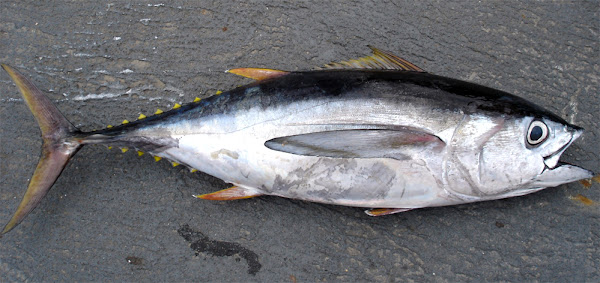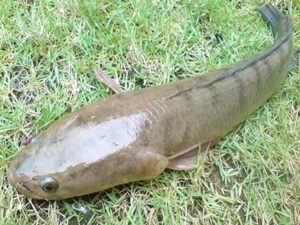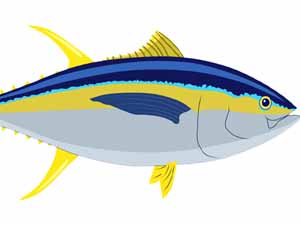The Bigeye Tuna fish is a species of fish which is an important food fish and also prized as a recreational game fish. It is a true tuna of the genus Thunnus, belonging to the wider mackerel family Scombridae.
It is one of the two species known as ‘ahi’ in Hawalian, and the another one is yellowfin tuna. This fish is found in the open waters of all tropical and temperate oceans. But it is not found in the Mediterranean Sea.
The Bigeye Tuna fish is available throughout the world. It is found in the tropical and subtropical waters of the Atlantic, Pacific and Indian Oceans.
But it is not available in the Mediterranean. However, read some more information about this fish species below.
Bigeye Tuna Fish Characteristics
The Bigeye Tuna fish are large species of fish, deepest near middle of first dorsal fin base. They are streamlined fish with large heads. And as the name suggests, they have relatively big eyes.
They have very long pectoral fins, reaching back beyond the start of the second dorsal fin in juveniles and the space between the first and second dorsal fin in adults. They have 13 or 14 dorsal spines.
Lower sides of their belly is whitish, and a lateral iridescent blue band runs along sides in live specimens.
Second dorsal and anal fins are of light yellow color, while the first dorsal fin is of deep yellow color. The finlets are of bright yellow color edged with black.
The mature Bigeye Tuna fish can grow up to 250 cm in length. And they can weight up to 180 kg live body weight. Photo and info from Wikipedia.

Diet
The Bigeye Tuna fish are mainly feed on epipelagic and mesopelagic fish, cephalopods and crustaceans.
Breeding
The Bigeye Tuna fish generally spawn throughout the year in tropical regions of the Pacific Ocean. They become seasonal at higher latitudes when sea surface temperature goes above 24 °C.
Their spawning occurs in June and July in the northwestern tropical Atlantic. And in the Gulf of Guinea, spawning occurs in January and February.
These fish generally take about 2-4 years for becoming mature. The mature females generally spawn at least twice a year. And they can lay between 2.9 and 6.3 million eggs per spawning. And they generally spawn over periods of the full moon.
Uses
The Bigeye Tuna fish is mainly used for food. It is very popular throughout the world.
Special Notes
The Bigeye Tuna fish is an extremely valuable fishery resource, especially for the sashimi market. Nearly 450,000 metric tones of fish were caught globally by commercial vessels in the year of 2012.
These fish have a unique physiology which allows them to forage in deeper colder waters and tolerate oxygen-poor waters. They are reported to tolerate ambient oxygen levels of 1.0 ml/L.
These fish are long-lived, with a maximum recorded lifespan of 16 years. However, review full breed profile of this fish in the table below.
| Name | Bigeye Tuna |
| Kingdom | Animalia |
| Phylum | Chordata |
| Class | Actinopterygii |
| Order | Perciformes |
| Family | Scombridae |
| Genus | Thunnus |
| Species | T. obesus |
| Binomial Name | Thunnus obesus |
| Other Names | Also known by many different names in different parts of the world |
| Breed Purpose | Food |
| Special Notes | Economically important fish species, found and popular throughout the world, maximum recorded lifespan of these fish is 16 years, today used mainly for food |
| Weight | Can reach up to 180 kg live body weight |
| Breeding Method | Natural |
| Climate Tolerance | Almost all climates |
| Body Color | Silver and grey |
| Rarity | Common |
| Availability | Europe |






